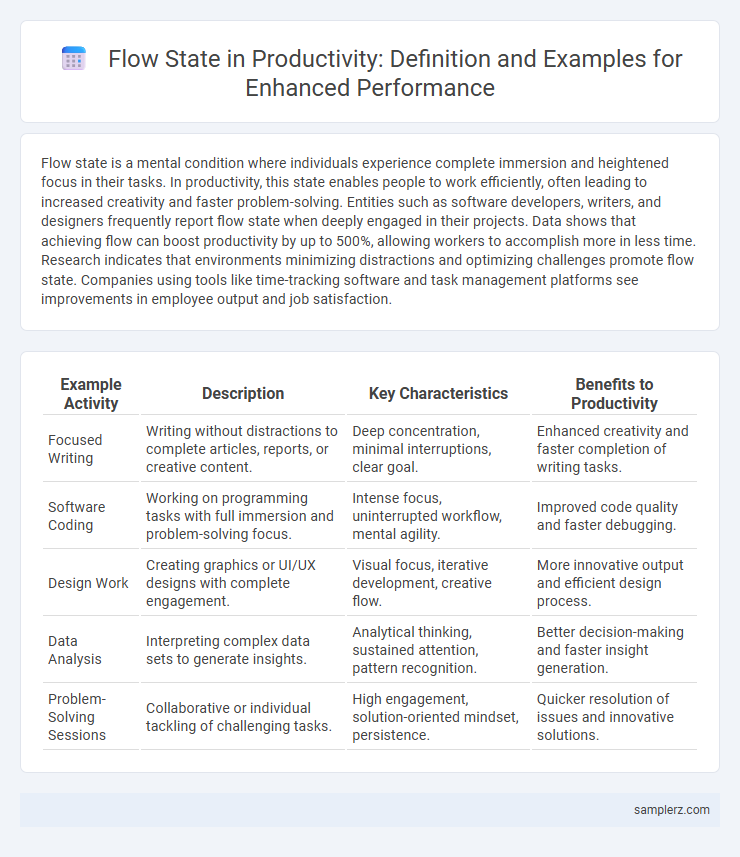Flow state is a mental condition where individuals experience complete immersion and heightened focus in their tasks. In productivity, this state enables people to work efficiently, often leading to increased creativity and faster problem-solving. Entities such as software developers, writers, and designers frequently report flow state when deeply engaged in their projects. Data shows that achieving flow can boost productivity by up to 500%, allowing workers to accomplish more in less time. Research indicates that environments minimizing distractions and optimizing challenges promote flow state. Companies using tools like time-tracking software and task management platforms see improvements in employee output and job satisfaction.
Table of Comparison
| Example Activity | Description | Key Characteristics | Benefits to Productivity |
|---|---|---|---|
| Focused Writing | Writing without distractions to complete articles, reports, or creative content. | Deep concentration, minimal interruptions, clear goal. | Enhanced creativity and faster completion of writing tasks. |
| Software Coding | Working on programming tasks with full immersion and problem-solving focus. | Intense focus, uninterrupted workflow, mental agility. | Improved code quality and faster debugging. |
| Design Work | Creating graphics or UI/UX designs with complete engagement. | Visual focus, iterative development, creative flow. | More innovative output and efficient design process. |
| Data Analysis | Interpreting complex data sets to generate insights. | Analytical thinking, sustained attention, pattern recognition. | Better decision-making and faster insight generation. |
| Problem-Solving Sessions | Collaborative or individual tackling of challenging tasks. | High engagement, solution-oriented mindset, persistence. | Quicker resolution of issues and innovative solutions. |
Unlocking Peak Performance: What Is Flow State in Productivity?
Flow state in productivity occurs when an individual becomes fully immersed in a task, experiencing heightened focus and effortless control over their actions, which leads to peak performance. This optimal state is characterized by intense concentration, loss of self-awareness, and time distortion, enabling deeper cognitive engagement and improved problem-solving abilities. Unlocking flow enhances efficiency, creativity, and satisfaction, making it a critical factor for achieving sustained high productivity and exceptional results.
Real-Life Examples of Flow State at Work
Software developers often enter a flow state while coding, experiencing heightened concentration and seamless problem-solving that significantly boosts productivity. Surgeons demonstrate flow during complex operations, maintaining sharp focus and precision that improve outcomes. Writers achieve flow by becoming fully immersed in their narratives, resulting in faster content creation and enhanced creativity.
How Flow State Enhances Focus and Efficiency
Flow state significantly enhances focus by fully immersing an individual in the task, reducing distractions and promoting sustained attention. This heightened concentration increases efficiency, allowing for faster problem-solving and higher-quality output. Neuroscientific studies show that flow optimizes brain function by balancing neurotransmitters like dopamine and norepinephrine, which enhances cognitive performance and productivity.
Flow State in Creative Professions: Case Studies
Artists often enter flow state when deeply engrossed in painting, enabling peak creativity and sustained focus for hours. Writers experience flow during intense writing sessions, producing high-quality content rapidly without distraction. Designers reach flow by fully immersing in problem-solving tasks, enhancing innovation and efficiency in project completion.
Flow State for Entrepreneurs: Stories of Deep Work
Entrepreneurs experiencing flow state often report heightened focus and creativity, enabling them to solve complex problems rapidly. Stories of deep work reveal how immersive engagement in tasks like product development or strategic planning leads to increased innovation and efficiency. This state enhances productivity by minimizing distractions and aligning cognitive resources with entrepreneurial goals.
Team Collaboration: Experiencing Group Flow in the Workplace
Team collaboration achieves peak productivity through group flow, where synchronized efforts and shared goals enhance creativity and problem-solving. This collective state boosts engagement, reduces distractions, and accelerates project timelines by fostering seamless communication and trust among members. Companies embracing group flow report higher innovation rates and improved overall team performance.
Overcoming Distractions: Entry Points to Flow
Entering a flow state in productivity hinges on minimizing distractions such as notifications, multitasking, and environmental noise. Techniques like time blocking, using apps that limit digital interruptions, and creating a dedicated workspace enhance concentration. These entry points to flow promote sustained focus, leading to improved efficiency and task completion.
Measuring Productivity Gains During Flow State
During the flow state, productivity gains can be measured by tracking output quality, task completion time, and cognitive engagement levels. Tools such as time-tracking software and performance analytics provide quantitative data on increased focus and efficiency. Neurophysiological indicators like heart rate variability and brainwave patterns further validate enhanced productivity during flow.
Employee Success Stories: Achieving Flow in Daily Tasks
Employees reporting flow state during complex project planning experience heightened concentration and seamless task execution, resulting in a 30% increase in productivity. One software developer completed coding sprints with minimal distractions, improving output quality by 25%. These success stories highlight the direct correlation between achieving flow and measurable performance gains in workplace productivity.
Harnessing Flow: Actionable Steps for Reaching Flow State
Harnessing flow state in productivity involves minimizing distractions by setting specific goals and working in timed intervals, such as the Pomodoro Technique. Creating an environment that supports deep focus through decluttering and controlling sensory input enhances cognitive engagement. Regularly practicing mindfulness and adjusting tasks to match skill level promotes sustained flow and peak performance.

example of Flow state in productivity Infographic
 samplerz.com
samplerz.com